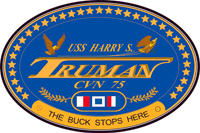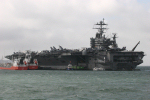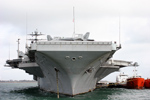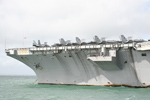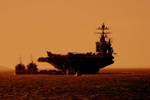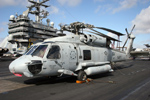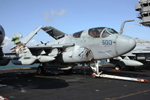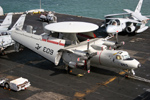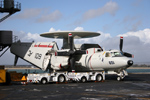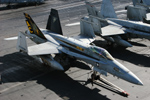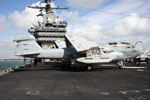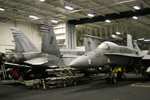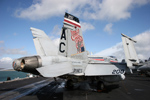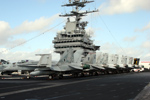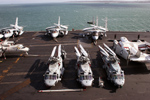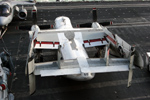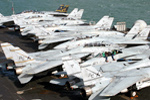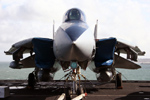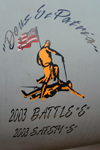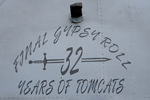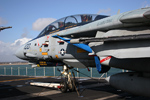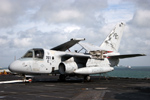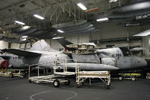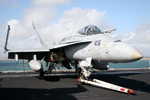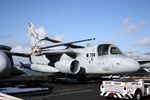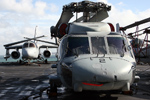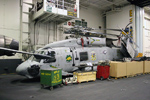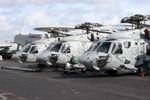On
March 19th the USS Harry S Truman, together with the other elements
of the strike group the USS Mason (DDG-87), USS Barry (DDG-52), USS
Monterey (CG-61), USNS Arctic (T-AOE 8), USS Albuquerque (SSN-706) and
Carrier Air Wing 3 (CVW-3) completed a six month deployment in the Persian
Gulf in support of “Operation Iraqi Freedom” (OIF) and the
undertaking of Maritime Support Operations (MSO). MSO establishes stability
and security in the maritime environment and increases the pressure
on those who use maritime methods for illegal purposes thus making MSO
very effective against those who use this environment for terrorist
activities. |
|
|
The
UK visit of the Truman was a last minute change of plan – originally
the intentions had been to make a port visit to Cape Town, South Africa
but due to administrational complications the visit had to be aborted.
With the Truman having made previous port visits in Bahrain and Dubai,
the UK port visit was the last opportunity for the crew to enjoy some
well earned shore leave before heading home to Norfolk Naval Base in
Virginia. |
CVW-3 comprises eight squadrons – seven navy squadrons and one Marine Corps squadron - which, when called upon, provide a formidable strike force. These squadrons were: VF-32 “Swordsmen” with F-14Bs, VFA-37 “Bulls” with F/A-18Cs, VFA-105 “Gunslingers” with F/A-18Cs, VAW-126 “Seahawks” with E-2Cs, VAQ-130 “Zappers” with EA-6Bs, VS-22 “Checkmates” with S-3Bs, HS-7 “Dusty Dogs” with SH-60F/HH-60Hs and VMFA-115 “Silver Eagles” with F/A-18A+s. Each squadron had painted at least one aircraft in a high-colour scheme and these aircraft are usually assigned to the relevant squadron commander and executive officer. The US Marine Corps squadrons are now integral parts of carrier air wings and are regularly embarked on the aircraft carriers where they play a vital operational role alongside their Navy counterparts. Two C-2A Greyhound aircraft of VRC-40 “Rawhides” det.5 were also onboard; these aircraft provide Carrier Onboard Delivery (COD) duties, regularly flying to and from shore bases to drop off or collect personnel as well as cargo support to the carrier. During their six month deployment, the squadrons of CVW-3 were regularly involved in supporting US and Coalition ground forces in Iraq and flew a total of 2,577 sorties amassing approximately 13,000 hours flight time. |
|
|
For
VF-32 “Swordsmen”, flying the Grumman F-14B Tomcat, this
was their final cruise with this aircraft type. They returned to NAS
Oceana where they ended Tomcat operations in October 2005 and begun
the transition to the Boeing F/A-18F Super Hornet. VF-32 uses the call-sign
“Gypsy” so it was fitting for all the aircraft to carry
the inscription of “Final Gypsy Roll – 32 Years of Tomcats”
as well as additional nose art depicting a victorious American swordsman
with the words “Deus et Patria” (God and Fatherland) above
it. For many UK aviation enthusiasts, the Tomcat has been held in high-esteem
and is probably the one aircraft that many would like to see at a UK
air show, unfortunately for the Tomcats of VF-32 they would be the last
Tomcats to be seen in the UK. By the end of 2006 all remaining Tomcats
will have been retired from active service with the US Navy, many being
scrapped whilst others will go to museums or be preserved at military
bases. |
Another
squadron, VS-22 “Checkmates”, and their S-3B Viking aircraft
had also deployed with CVW-3 and the USS Harry S Truman for the last
time; the squadron will transfer from CVW-3 and be re-assigned to CVW-17.
During their deployment VS-22 flew 1,170 sorties and 3,220 hours in
support of OIF, patrolling the oil infrastructure in the Arabian Gulf
during Operation Sea Dragon II missions. VS-22 are expected to stay
with CVW-17 until 2009, when the command will be disestablished making
thus making VS-22 the last S-3B squadron in the fleet. |
|
|
The
Truman was called into action at the beginning of September 2005, when
it would undertake a very different role because of Hurricane Katrina.
The US Gulf Coast coastlines of the states of Louisiana, Alabama and
Mississippi had all suffered catastrophic damage when Hurricane Katrina
hit land. New Orleans had borne the brunt of the ferocity of the hurricane
and the city was devastated, the levies were breached and the city and
100 mile surrounding area heavily flooded. The US government declared
a national emergency and initiated a massive humanitarian aid and relief
programme. The Truman was to serve as a command centre and an afloat
staging base, no carrier air wing would be embarked as an expected 30-40
helicopters, US Navy SH-60F, HH-60H and SH-60B Seahawks and US Army
UH-60 Blackhawk’s, would use the carrier to support search-and-rescue
operations. The Truman received 1.3 million gallons of jet fuel for
the helos, 20,000 bottles of water, more than 17,000 meals as well as
blankets, sheets and cots. The carrier was anchored 50 miles off the
coast of Mobile, Alabama whilst relief operations were conducted and
remained there for approximately three weeks before finally returning
to Norfolk Naval Base, Va on 22nd September 2005. |
| With grateful thanks to Anton Hanney, Royal Navy Press Office Portsmouth; Chief Eric Harrison, Public Affairs Officer USS Harry S. Truman; Lt. Cmdr. Elissa Smith, Public Affairs Officer USS Harry S. Truman; Lt. Cmdr. Terrence Dudley, US Navy Public Affairs; Petty Officer Daniels, US Navy Public Affairs for making this visit possible and to the crew of the USS Harry S. Truman for their hospitality. |

